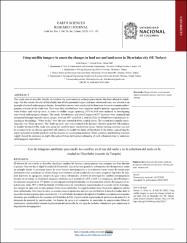| dc.contributor.author | Dursun, Felat | |
| dc.contributor.author | Zorlu, Kemal | |
| dc.contributor.author | Gül, Murat | |
| dc.date.accessioned | 2022-09-27T08:52:02Z | |
| dc.date.available | 2022-09-27T08:52:02Z | |
| dc.date.issued | 2022 | en_US |
| dc.identifier.citation | Dursun, F., Zorlu, K., & Gül, M. (2022). Using satellite imagery to assess the changes in land use and land cover in Diyarbakır city (SE Turkey). Earth Sciences Research Journal, 26(2), 119-130. https://doi.org/10.15446/esrj.v26n2.92417 | en_US |
| dc.identifier.issn | 1794-6190 / 2339-3459 | |
| dc.identifier.uri | https://doi.org/10.15446/esrj.v26n2.92417 | |
| dc.identifier.uri | https://hdl.handle.net/20.500.12809/10306 | |
| dc.description.abstract | This study aims to describe, classify, and analyze the most common anthropogenic factors that have altered the lands-cape. For this reason, the city of Diyarbakır, one of Mesopotamia’s largest and most urbanized cities, was chosen as an example of several anthropogenic factors. Several field surveys were conducted to determine the most common anthropogenic activities in the study area. They were then classified into four categories: marble quarries, aggregate quarries, water bodies, and built-up areas. A series of satellite images spanning 1975 to 2019 were analyzed by investigating time-based anthropogenic changes. The trends, distributions, and overall impacts of 177 locations were examined and monitored through remotely sensed images. Between 1975 and 2019, a total of 25224 ha of land were transformed, ac-cording to the findings. “Water bodies” were the most extended of the studied classes. The second most rapidly expan-ding class was “Built-up areas.” The “Built-up areas” class was assumed to be the most effective agent that will continue to modify the land of the study area, given the need for more construction spaces. Surface mining activities can also be assumed to be an efficient agent that will continue to modify the lands of Diyarbakır in the future, considering the export potential of marble products and the demand for construction material. Water resources and building materials supply should be examined in depth throughout future development planning of such urbanized cities to minimize anthropogenic degradation. | en_US |
| dc.description.abstract | El objetivo de este estudio es describir, clasificar y analizar los factores antropogénicos más comunes que han alterado el paisaje. Con este fin se eligió la ciudad de Diyarbakir, una de las más grandes y urbanizadas de Mesopotamia, como un ejemplo donde se presentan varios de estos factores antropogénicos y se realizaron varias visitas de campo para determinar estas actividades en el área. Luego estos factores fueron clasificados en cuatro categorías: depósitos de mármol, depósitos de agregados, cuerpos de agua y áreas urbanizadas. A través de investigar los cambios antropogénicos
basados en el tiempo se analizaron imágenes satelitales en el período de 1975 a 2019. Las tendencias, distribuciones y los impactos en general de 177 puntos se investigaron retrospectivamente y se monitorearon a través de imágenes de teledetección. Entre 1975 y 2019 un total de 25224 hectáreas de tierra fueron transformadas de acuerdo con los hallazgos. Los cuerpos de agua eran los más grandes de las clases estudiadas. La segunda mayor clase y la de más expansión son las áreas urbanizadas. Esta clase de áreas se asumió como el agente más efectivo que modificará el área de estudio, dada la
necesidad de más espacios para construcción. Las actividades de minería de superficie también se asumen como agentes eficientes que modificarán los espacios de Diyarbakır debido al potencial de exportación de productos de mármol y la demanda de material de construcción. Las fuentes de aguas y el suministro de materiales de construcción deben de examinarse a profundidad durante la planeación del desarrollo de este tipo de ciudades urbanizadas para minimizar la degradación antropogénica. | en_US |
| dc.item-language.iso | eng | en_US |
| dc.publisher | Universidad Nacional de Colombia | en_US |
| dc.relation.isversionof | 10.15446/esrj.v26n2.92417 | en_US |
| dc.item-rights | info:eu-repo/semantics/openAccess | en_US |
| dc.subject | Change detection | en_US |
| dc.subject | Environmental impact assessment | en_US |
| dc.subject | Land use | en_US |
| dc.subject | Land cover | en_US |
| dc.subject | Remote sensing | en_US |
| dc.subject | Detección del cambio | en_US |
| dc.subject | Medición del impacto ambiental | en_US |
| dc.subject | Uso del suelo | en_US |
| dc.subject | Cobertura del suelo | en_US |
| dc.subject | Teledetección | en_US |
| dc.title | Using satellite imagery to assess the changes in land use and land cover in Diyarbakır city (SE Turkey) | en_US |
| dc.item-title.alternative | Uso de imágenes satelitales para medir los cambios en el uso del suelo y en la cobertura del suelo en la ciudad de Diyarbakır (sureste de Turquía)] | en_US |
| dc.item-type | article | en_US |
| dc.contributor.department | MÜ, Mühendislik Fakültesi, Jeoloji Mühendisliği Bölümü | en_US |
| dc.contributor.authorID | 0000-0003-1555-6426 | en_US |
| dc.contributor.institutionauthor | Gül, Murat | |
| dc.identifier.volume | 26 | en_US |
| dc.identifier.issue | 2 | en_US |
| dc.identifier.startpage | 119 | en_US |
| dc.identifier.endpage | 130 | en_US |
| dc.relation.journal | Earth Sciences Research Journal | en_US |
| dc.relation.publicationcategory | Makale - Uluslararası Hakemli Dergi - Kurum Öğretim Elemanı | en_US |


















